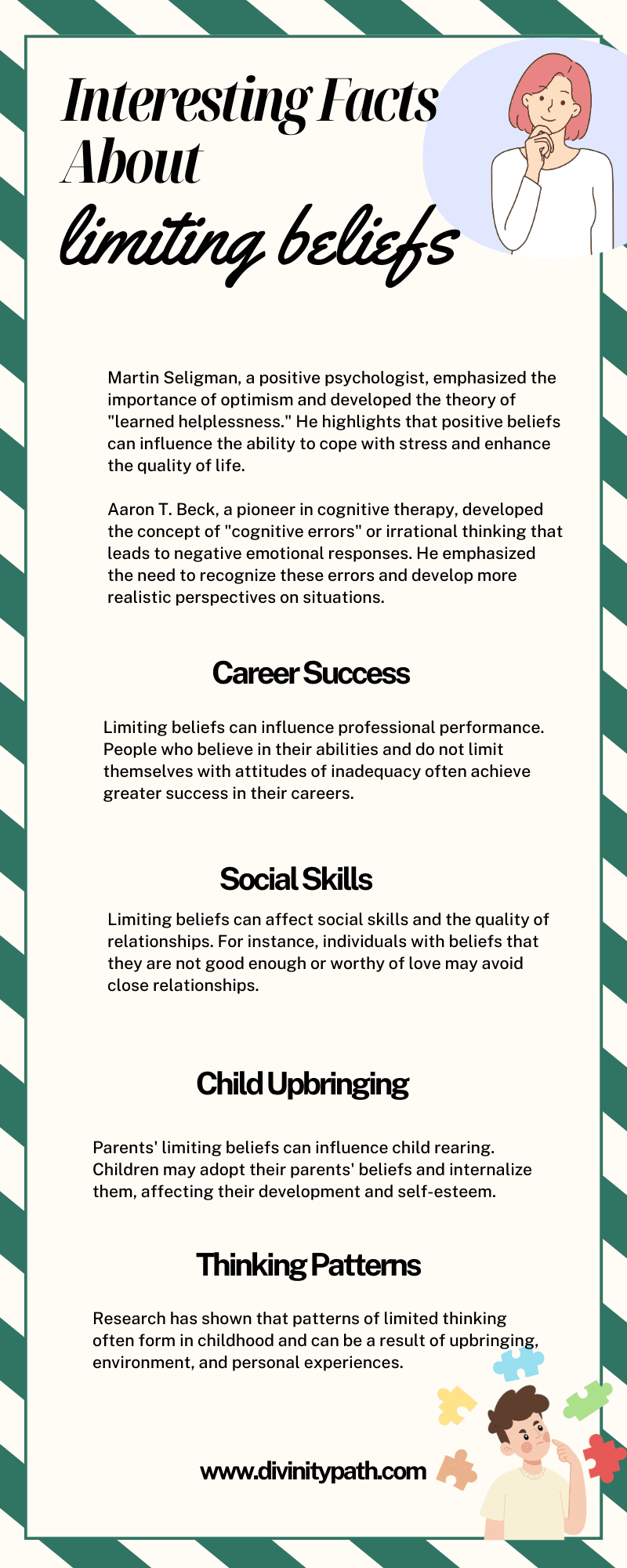How To Easily Get Out Of Limiting Beliefs About Everything?
People operate from their deeply ingrained beliefs and assumptions about themselves and the world in general. As James Allen wisely said: “Man’s actions always stem from beliefs.” These beliefs are most powerful precisely when life challenges us. Now, let’s explore the labyrinth of limiting beliefs and discover the path to a world where all goals are achievable.
What are limiting beliefs?
Let’s take a moment to travel back to elementary school. Do you remember learning about the shape of the Earth, the history of world wars, pyramids, and the like? The knowledge we gained turned into deeply ingrained beliefs that we perceive as absolute truth. Perhaps you’ve encountered sources that challenged your beliefs. Our minds are boundless, much like the worlds surrounding us.
Beliefs are rooted in experiences, perspectives, and societal learned guidelines. Beliefs can be categorized as rigid or flexible. We often adopt beliefs from family, community, and culture, but we must understand they are closely linked to our thoughts and emotions. We are subject to certain patterns prevailing in our environment, shaping our reality.
Positive vs. Negative Beliefs
On one hand, limiting beliefs can be positively beneficial, while on the other, they can hold us back from what we truly desire. Positive beliefs drive us toward actions with expected positive outcomes. However, they can also hinder us from pursuing what we genuinely want. For example, I dreamed of working abroad for years but felt inadequate due to my language skills.
Rigid beliefs confine themselves to a limited reality. For instance, if we were ingrained with the belief that infidelity or divorce is unacceptable, it strongly influences us, to be more resistant to change.
Flexible beliefs are much more adaptable, allowing us to change the rules based on experience. For example, initially thinking, meditation is dull and meaningless, but trying it anyway, eventually realizing its positive impact.

Common Phrases of Limiting Beliefs:
“I want to, but…”
Example: “I want to change jobs, but what if I don’t find a better one?”
This phrase emphasizes the desire for change while simultaneously introducing doubts and fears that hinder action.
“What if…”
Example: “What if I fail?” or “What if I’m wrong?”
This expression often reflects a fear of failure, hindering individuals from attempting something new or risky.
“I can’t…”
Example: “I can’t handle this challenge” or “I can’t do this.”
This statement indicates a lack of belief in one’s abilities, preventing the individual from facing challenges.
“I’ve always been like this…”
Example: “I’ve always been insecure” or “I’ve always been unsuccessful.”
Such an expression reflects a belief in the permanence of certain traits, hindering personal growth and change.
“I’m not good enough…”
Example: “I’m not smart enough” or “I’m not capable enough.”
This statement signifies a lack of self-confidence and negative self-assessment.
“This isn’t for me…”
Example: “Entrepreneurship isn’t for me” or “Happiness in love, isn’t for me.”
The phrase “isn’t for me” limits possibilities and confines the person to a frame of limited options.
“Only lucky people have that luck…”
Example: “Only lucky people succeed in their careers” or “Only lucky people find true love.”
This type of expression conveys the belief that success and happiness are reserved for selected individuals.
How to Overcome Limiting Beliefs: Simple Tips
Cognitive Restructuring
Cognitive Behavioral Therapy (CBT), usually involving collaboration with a therapist, enables individuals to recognize faulty thought patterns and learn techniques to reshape negative patterns. These techniques for shaping and improving thinking habits can also be applied individually.
How To Prepare For Christmas Holidays, Stress-free
Here are some of these techniques:
Self-awareness
To change one’s mindset, it’s essential to engage in self-observation, noticing negative thoughts and identifying when and where they occur. Keeping a journal is a beneficial method. Asking questions
Pose questions when confronted with negative thoughts, such as:
- Is this thought true?
- How can I see this from another perspective?
- What limiting beliefs do I notice when thinking about my goals or challenges?
- What are common cognitive distortions I observe in myself (e.g., black-and-white thinking, catastrophizing)?
- What events or experiences contributed to the formation of my limiting beliefs?
- Is there a recurring pattern in these situations?
- How would I respond to this limiting thought if I took on the role of an advisor or friend?
- How do I feel when thinking about my limiting beliefs?
Gathering evidence
This is the phase where individuals analyze their thoughts, assumptions, and beliefs, seeking objective evidence that either supports or challenges these cognitive patterns. To gather evidence, start by identifying the thought patterns you want to restructure (e.g., black-and-white thinking, catastrophizing).
The next step is to track situations, so record all instances in which this thought pattern occurs. Pay attention to the circumstances, people, and factors that trigger such thoughts in you. To analyze the evidence, simply ask yourself these questions:
- What are the actual pieces of evidence for this belief?
- Are there alternative explanations for the situation?
- How would other people see this?
- What are the consequences of this thinking pattern?
- Maintain openness to alternative perspectives:
- Stay open-minded, contemplate other possible interpretations of situations, and avoid insisting on a singular viewpoint. Allow room for new possibilities.
Advantages and disadvantages of thought patterns
Delve into an analysis of the benefits and drawbacks stemming from a particular thought pattern. Consider the consequences of maintaining a specific way of thinking and how changing this pattern would impact your feelings, relationships, career, and overall quality of life. Here are some questions:
- What are the benefits of maintaining this thought pattern in your life?
- How do you feel when maintaining this thought pattern? What are the current feelings and emotions?
- Evaluate the emotional costs of this thought pattern. How does it affect your overall emotional well-being?
- How does this thought pattern manifest in your relationships with friends, family, and colleagues?
- Reflect on work efficiency. How does maintaining this thought pattern influence your work and productivity?
- Do you notice any long-term consequences due to maintaining this way of thinking? How do you envision your future in this light?
- How does this thought pattern affect your self-esteem? Do you feel more or less confident?
- What are the benefits if you decide to change this thought pattern? How would it affect your emotional well-being, relationships, and work performance?
- Do you believe that the current benefits of maintaining this thought pattern are worth the potential negative consequences?
- What are your long-term goals, and how would changing this thought pattern impact their achievement?
- How might a different way of thinking influence your ability to cope with stress and life challenges?
- Do you think changing this thought pattern would improve your quality of life? How?
- How would your self-image and relationships look if you decided to change this thought pattern?
Testing new explanations
People often make assumptions without knowing the background. Here, your task is to consciously change thought patterns. For example: If a friend doesn’t respond to your message, instead of thinking they no longer like you, flip the thought into a positive one, perhaps they just don’t have time at the moment.
How To Overcome Materialism And Discover Lasting Happiness
Similarly, instead of thinking: “I wasn’t invited to the party, so I must have been excluded,” choose a positive alternative, maybe it was a coincidence or limited space.
Another example: Instead of believing, “My boss criticized me, so I’m incapable and not good enough for this job,” replace this thought with an opportunity for improvement and recognizing your own strengths, acknowledging where you are strong and where you can still improve.
Awesome Solo Date Ideas for Guys: Make Time for You
Rational-Emotive Therapy (RET)
This technique focuses on identifying and changing irrational beliefs that lead to negative emotional responses, developed by Albert Ellis. The main emphasis of this therapy is to recognize, challenge, and change irrational and harmful beliefs. Here are some techniques that you can also use:
ABC Model
In this model, you identify A – Activating event, B – Beliefs, and C – Consequences. Through this model, you can analyze thoughts related to emotions. Let’s look at an example:
Activating Event (A):
Jane was invited to a party with her friends. While socializing, she noticed that people in the group started talking and laughing but didn’t include her in the conversation.
Beliefs (B):
Jane begins to feel anxiety and sadness. Her irrational beliefs are associated with black-and-white thinking and personalization. She starts thinking, “People obviously don’t like me. If I were interested enough, they would include me in the conversation. I’m always excluded.”
Consequences (C):
Jane becomes withdrawn and quietly observes the party. She doesn’t engage in conversations and feels lonely. This affects her mood as she feels unworthy of company.
Dr. Albert Ellis added DE to the basic ABC model, where D – Disputation and E – Effect.
Disputation (D):
Jane recognizes her irrational beliefs and begins to challenge them. Instead of absolutizing the situation, she starts thinking, “Is it true that people necessarily don’t like me? Are there other possible explanations for their behavior?”
Effect (E):
As Jane begins to challenge her beliefs, she realizes that it’s not necessary that she is excluded. Perhaps people were engaged in a specific conversation she didn’t hear, or they didn’t notice she wanted to participate. Changing her perspective influences her emotional state.
Self-Motivation
Self-motivation directs your focus on positive aspects and possibilities rather than negatives. This can help you break limiting beliefs and negative thinking. Develop positive affirmations and motivational statements. It’s important to focus on encouraging yourself with rational beliefs.
Techniques For Time Management And Better Planning Of The Day
Utilizing Cognitive-Behavioral Therapy (CBT) Techniques
CBT techniques focus on recognizing and changing negative thought patterns linked to emotional and behavioral responses. It involves setting realistic goals, redirecting attention from negative thoughts, and building positive connections.
Your Task:
- Learn to recognize your negative thought patterns and limiting beliefs.
- Keeping a thought journal is an excellent way to start tracking negative thoughts and identifying patterns. Record situations, feelings, and thoughts.
- Learn to recognize irrational beliefs, such as absolute statements or exaggeration of negative consequences.
- Use affirmations to replace negative beliefs, promoting self-esteem and confidence.
- Set realistic and achievable goals. Follow small steps to climb towards success.
- Explore deeper layers of your unconscious mind that influence belief formation. Reflect on childhood experiences and patterns contributing to specific
Explore Deeper
Explore the deeper layers of your subconscious mind that influence the formation of beliefs. Reflect on childhood experiences and patterns that have contributed to the shaping of certain beliefs and fears you may harbor. Pay attention to your dreams.
Mindfulness Meditation
This technique involves focusing on the present experience without engaging in reactions or judgments. Try redirecting your attention to your breath, sensations in your body, and other elements of the current moment. Try to establish a consistent practice, making it a part of your daily routine.
How To Gain And Maintain Motivation During Difficult Times
Through this practice, you’ll learn to observe thoughts that come and go in your mind. Simply observe them without judgment. This will enable you to accept things as they are, shedding unnecessary emotional burdens.
Dive into Your Qualities
List your positive qualities and visualize how you would feel and see life beyond limiting beliefs. This way, you’ll develop a healthy relationship with yourself and your environment, creating a shield to overcome obstacles.
Embrace Challenges, Even Those That Scare You
Accepting challenges opens the door to new experiences, insights, and opportunities for progress. This, in turn, breaks some of your limiting beliefs. How to start? Here’s how:
- Identify challenges that have frightened you. These could be social situations that made you uncertain or physical activities that weren’t entirely comfortable.
- Set small goals for each week, such as sharing your ideas at a work meeting.
- Establish achievable goals that are still beyond your comfort zone but remain attainable.
- Challenge your limiting beliefs. For example, if you fear opening up to someone due to past betrayal and the belief that all people are the same, challenge yourself and give it a chance.
Incorrect Limiting Beliefs?
There are no inherently good or bad beliefs; it’s about beliefs that open positive doors in our lives and those that hinder our life journey. Some beliefs restrict us from living a fuller life. For instance, if you believe you’re unworthy of love or uninteresting, you’ll unconsciously avoid relationships, reinforcing that belief in reality.
So, start observing your behaviors and beliefs, embarking on a path of change. One of my profound beliefs was that a person cannot change, that character remains eternal. I built this mindset based on society and the environment around me.
However, as I took a step closer to myself, this belief slowly lost its power, and my awareness began to strengthen and expand. I started changing my thoughts and proved to myself how profoundly one can transform. What are your experiences? Wishing you all the best until next time!
“As many people as there are in the world, there are also as many different worlds”.









